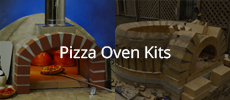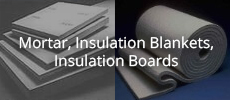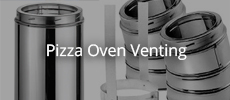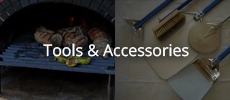Re: Thermocouple design for oven
For my BOM:
KMQSS-125U-6, 3 each, 1/8 Stainless sheath 6" K-type with miniature connectors.
That link shows a probe that is good up to 425?F I would think it needs to go higher... say up to 1000?F. Maybe like their TJ36-CASUP-316U-12. Just an observation... I know absolutely nothing about TC's.
Announcement
Collapse
No announcement yet.
Thermocouple design for oven
Collapse
X
-
Re: Thermocouple design for oven
Like Ken I am a techno-geek, unlike Ken, I have no restraint of this trait and spent a fair number of dollars on pre-made tcs with varying lengths of leads and sheathing all connecting to a display with data logging, wireless connection to my laptop and twenty functions I have yet to read about. What I found is what you read above, that the oven and its handling of heat is entirely predictable (compared to itself over time), you just learn that quicker with tcs. Mine are installed top o dome about 1" from inside surface, top of dome outside surface, left and right side 1" from inside surface half way up dome, left outer surface, close to center of floor 1 1/4" from cooking surface. Would I do it again? Not at those costs, but the solution below lifted from a fellow wfo builder in Florida is the simple approach you are looking for and makes it cheap to learn about your oven. I just wish I had found the post many bucks and two beatings earlier (the reader billed seperate from the tcs).
Hope this helps,
Jim
Thermocouples:
Until I read "The Bread Builders" book I had no idea what a thermocouple was. I Googled "thermocouple" and started reading and reading and reading. Anyway, here is what you need to know:
When metal is heated, it generates a very low electric current
Different metals generate different kinds of electric currents when heated
A thermocouple wire contains 2 wires (one positive & one negative)
Each wire is a different kind of metal
A thermocouple thermometer converts the difference is electric current between the 2 wires into degrees Fahrenheit (or Celciuis)
A thermocouple will measure the temperature where both wires touch
There are a lot of different types of thermocouples. The one you are looking for is Type K
To measure the temperature in the oven, you will need 3 components:
Thermocouple wire
Thermocouple connector
Thermocouple Thermometer
You can buy thermocouple wires (and connectors) pre-assembled but after doing some research I decided I could assemble everything myself a lot cheaper. If you have a basic wire cutter, and you are not afraid to use a screwdriver, don't go for the pre-assembled stuff.
I bought my supplies online from omega.com. Here is what I bought:
One HH-K-24-25 (= 25 feet of High Temp Glass insulated 24 Gauge Thermocouple K wire)
Four SMP-K-M (= Glass-filled nylon Thermocouple K Male Connector)
This will give you enough to make four 6 foot thermouples. When you get the wire, cut it into the desired length, connect one side to the connector and twist the wires on the other end together. The twisted wire side is where it's going to measure the temperature. Drill a hole into your firebrick and insert the twisted wire. The tip of the wire should be inside the brick and about 1" from the fire chamber. Fill up the hole with fireclay mortar or refractory cement. Voila, you got yourself a thermocouple. One thing that can be confusing is trying to figure out which wire is the negative or positive one when connecting the wire to the connector. Thermocouple wires are usually color coded but unfortunately they're not always color coded the same
Here is a fail proof trick: The wire that is attracted to a magnet is always the negative one.
Oh, and one last thing I learned: the smaller the gauge of the wire, the thicker it will be. Just think: "Small is the new Big"
Thermometer (type-K):
Although Omega does sell special thermocouple thermometers, they all seemed more than I was willing to spend (even the "value" ones). After a good amount of Googling, I determined that Sears was my new best friend. I found out that some of their multimeters can also read type-k thermocouples. Make sure to read the fineprint and see up until what temperature it will read. For $30 I bought Craftsman model #82139. These multimeters are not as accurate as the dedicated type-k thermometers but that's ok with me. I didn't find it worth to pay $100 extra to know if something was 700 or 710 degrees.Last edited by jcg31; 04-19-2008, 06:31 AM.
Leave a comment:
-
Re: Thermocouple design for oven
I work with TC's everyday and just had to know how my oven performed, so that is why I installed mine. We all could give you temp curves but there are too many variables in our custom oven construction (each is different) for them to be accurate.
As for where to buy, that is easy, Temperature
For my BOM:
KMQSS-125U-6, 3 each, 1/8 Stainless sheath 6" K-type with miniature connectors
TECK10-9, 3 each, 10ft extensions.*
HH308 Mini thermometer - reads 2 K-type TC's at a time.
OSXL653 IR gun thermometer +
*The extension wires were cheaper than a spool and connectors seperately.
+ Could look at the OS562 , is IR gun that also reads a K-type TC input so 2 meters for price of one.
Originally posted by maburton View Postthanks for the info, I read those discussions. I am an engineer and I work with engineers. But I dont think I am really an engineer because I dont think I understand 1% of what they are talking about. I dont want a complicated discusion about where and why. I just want a simple design with manufacturer part numbers and quantities and where to purchase.
I think it may be a waste of time, sometimes I spend $ on useless high tech stuff also and never use it beacuse I am too lazy.
Is there anybody out there has a simple solution?
thanks for the links I enjoyed scanning them.
Leave a comment:
-
Re: Thermocouple design for oven
thanks for the info, I read those discussions. I am an engineer and I work with engineers. But I dont think I am really an engineer because I dont think I understand 1% of what they are talking about. I dont want a complicated discusion about where and why. I just want a simple design with manufacturer part numbers and quantities and where to purchase.
I think it may be a waste of time, sometimes I spend $ on useless high tech stuff also and never use it beacuse I am too lazy.
Is there anybody out there has a simple solution?
thanks for the links I enjoyed scanning them.
Leave a comment:
-
Re: Thermocouple design for oven
MABurton,
Don't let us talk you out of TC's to easily. We have a few guys on the board that really like them. I'm hoping some of our Thermocouple users will chime in and give their 2 cents
There have been several really in-depth TC discussions in the past. Try doing a search... here's a couple threads to get you started:
Leave a comment:
-
Re: Thermocouple design for oven
since the response is to not add the thermocouples, can someone send me the curves for heating and cooling a well insulated 40" oven? once the oven has risen to 800 degrees, how long does it take for this heat to saturate the core?
Leave a comment:
-
Re: Thermocouple design for oven
If you are a commercial baker who needs consistency, thermocouples are a real help. Getting bread the right color on the outside while not being gummy or dried out on the inside requires accurate temperatures of the floor and dome. For pizza, not so much. Get it white, push the fire over, let it sit half an hour, you're good to go. I think that the infrared gun is the way to go for home use.
Leave a comment:
-
Re: Thermocouple design for oven
I'm a proud member of the no-probe club. I'm a techie at heart but decided to do it the old fashioned way. I figured these ovens have been working great for hundreds of years without probes.
I do have the Forno Bravo Infrared/Laser probe. It works great and is a fun gadget.
When all else fails, if you stick your hand in the oven and singe the hair on your forearm, you're probably ready for pizza!
Leave a comment:
-
Re: Thermocouple design for oven
That’s the $10,000 question. Some people want 6 or 7 probes and like to track and graph and log each and every firing. Others just want 2 or 3 probes to show an average air temp or floor temp. What is your feeling on how much info you want?
You may even decide (Since you asked for "a simple design for measuring the temp on my oven") to just go with an infrared temp gun. They work great for surface temperatures and their useful around the house as well. The gun I am using even has an input to attach and read external probes which makes it even more useful.
I have seen quite a few comments from people who have installed probes that they hardly use them. They were good in the beginning to learn, but once you "know" your oven they were not necessary. If you set on using probes, I am sure you will get several responses with help on placing and buying. Good Luck
-Michael
Leave a comment:
-
Thermocouple design for oven
can anyone give a simple design for measuring the temp on my oven? I have built the foundation and am ready to pour the slab. I need to start planning for temp probes.
Questions, how many temp probes placed where? where do I purchase them, what is the device that reads the temp probes? Can anyone provide a BOM (bill of materials) that I need to purchase to measure the perfomance of my oven?
what do I buy, how many, what are the connector types and most importantly, where do I buy. I saw where someone bought stuff on ebay and I went there, but I dont know what to purchase?
I need a design. thanksTags: None






Leave a comment: